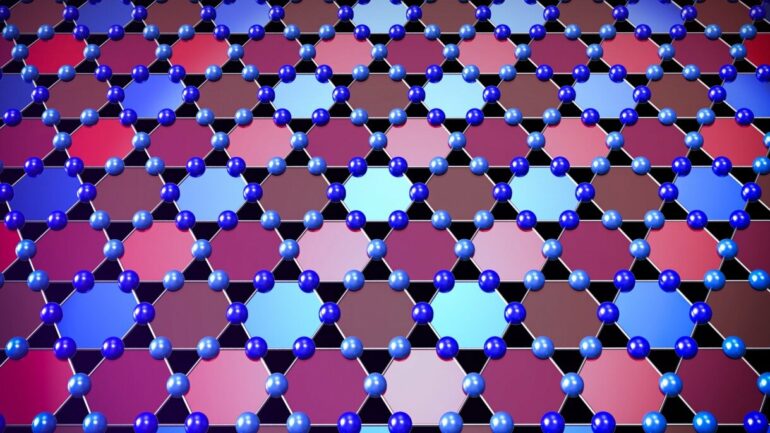A new RMIT-led international collaboration published in February has uncovered, for the first time, a distinct disorder-driven bosonic superconductor-insulator transition.
The discovery outlines a global picture of the giant anomalous Hall effect and reveals its correlation with the unconventional charge density wave in the AV3Sb5 kagome metal family, with potential applications in future ultra-low energy electronics.
Superconductors, which can transmit electricity without energy dissipation, hold great promise for the development of future low-energy electronics technologies, and are already applied in diverse fields such as hover trains and high-strength magnets (such as medical MRIs).
However, precisely how the superconductivity forms and works in many materials remains an unsolved issue and limits its applications.
Recently, a new kagome superconductor family AV3Sb5 has attracted intensive interest for their novel properties. “Kagome” materials feature an unusual lattice named for a Japanese basket-weave pattern with corner-sharing triangles.
The AV3Sb5 materials (where A refers to cesium, rubidium, or potassium) provide ideal platforms for physics studies such as topology and strong correlations, but despite many recent investigations, the origin of the material’s giant anomalous Hall effect and superconductivity remain in debate.
The FLEET-led collaboration of researchers at RMIT University (Australia) and partner organization the High Magnetic Field Laboratory (China) confirm for the first time the electric control of superconductivity and AHE in a van der Waals kagome metal CsV3Sb5.
Manipulating giant anomalous Hall effect via reversible proton intercalation
Possessing topological electron bands and geometrical frustration of vanadium lattices, the layered kagome metals AV3Sb5 have attracted great interests in condensed matter physics due to the many quantum phenomena that they support including:
unconventional, novel nematic orderchiral charge density ordergiant anomalous Hall effect (AHE), andthe interplay between two-gap superconductivity and charge density wave (CDW) in AV3Sb5.
Moreover, the origin of giant AHE in AV3Sb5 and its correlation with chiral CDW remain elusive, in spite of several recently proposed mechanisms including the extrinsic skew scattering of Dirac quasiparticles with frustrated magnetic sublattice, the orbital currents of novel chiral charge order and the chiral flux phase in the CDW phase.
“Up to now, we had obtained many intriguing results with proton gate technique in vdW spintronic devices. Since this technique can effectively modulate the carrier density up to 1021 cm-3, we would like to apply it on AV3Sb5, which harbors a similar carrier density level,” says the new study’s first author, FLEET Research Fellow Dr. Guolin Zheng (RMIT).
“The ability to tune the carrier density and the corresponding Fermi surfaces would play a vital role in understanding and manipulating these novel quantum states and would potentially realize some exotic quantum phase transitions.”
The team chose to test this theory on CsV3Sb5 which potentially has the largest spare atom space for proton intercalation. The devices were easily designed and fabricated based on the team’s rich experience in this field.
Their subsequent results with CsV3Sb5 depended strongly on material thickness.
“It was very difficult to effectively modulate the ‘thicker’ nanoflakes (more than 100 nm),” says co-first author, FLEET Research Fellow Dr. Cheng Tan (RMIT).
“But when the thickness went down to around 40 nm, the injection of the proton became quite easy,” says Cheng. “We even found that the injection is highly reversible. Indeed, we have seldom met such a proton-friendly material.”
Interestingly, with the evolving proton intercalation, the carrier type (or the “sign” of the Hall effect) could be modulated to either hole or electron type and the amplitude of the AHEs achieved were effectively tuned as well.
Further experimental and theoretical investigations indicate that this dramatic modulation of giant AHE originates from the Fermi level shift in the reconstructed band structures.
“The results of the gated AHE also revealed that the most possible origin of the AHE is skew scattering and this further improves our understanding on the kagome metal,” explains Guolin. “But we have not yet observed superconductor-insulator transition in 40 nm nanoflakes.”
“We must further try thinner CsV3Sb5 nanoflakes to explore this.”
Proton intercalation induced superconductor-to-‘failed insulator’ transition
The unique coexistence of electronic correlations and band topology in AV3Sb5 allows for investigating intriguing transitions of these correlated states, such as superconductor-insulator transition, a quantum phase transition usually tuned by disorders, magnetic fields and electric gating.
By decreasing the number of atomic layers, the team took further steps to explore the potential quantum phase transitions in CsV3Sb5.
“At first I directly tried some So Cheng changed the strategy and dealt with the 10~20nm thicker nanoflakes, as well as trying different electrode materials to seek a better electrical contact.
This strategy met with success. The team, surprisingly, observed that the critical temperature of the CDW phase decreased and the temperature-dependent resistance curves exhibit a clear superconductor-to-insulator transition under increasing proton injection.
“The proton intercalation introduced the disorder and suppressed both CDW and superconducting phase coherence,” says contributing-author A/Prof Lan Wang (also at RMIT). “And this gave rise to a superconductor-insulator transition associated with localized Cooper pairs and featuring a saturated sheet resistance reaching up to 106 Ω for temperature approaching zero, dubbed a ‘failed insulator.'”
“Our work uncovers a distinct disorder-driven bosonic superconductor-insulator transition, outlines a global picture of the giant AHE and reveals its correlation with the unconventional CDW in the AV3Sb5 family.”
“This significant and electrically-controlled superconductor-insulator transition and anomalous Hall effect in kagome metals should inspire more investigations of the relevant intriguing physics, with promise for energy-saving nanoelectronic devices.”
“Electrically controlled superconductor-to-failed insulator transition and giant anomalous Hall effect in kagome metal CsV3Sb5nanoflakes” was published in Nature Communications in February 2023.
More information:
Guolin Zheng et al, Electrically controlled superconductor-to-failed insulator transition and giant anomalous Hall effect in kagome metal CsV3Sb5 nanoflakes, Nature Communications (2023). DOI: 10.1038/s41467-023-36208-6
Citation:
Destroying the superconductivity in a kagome metal (2023, March 3)



